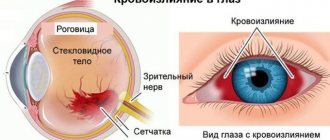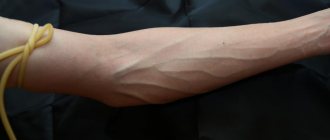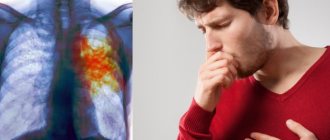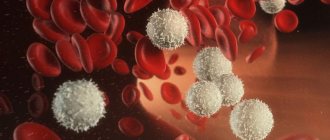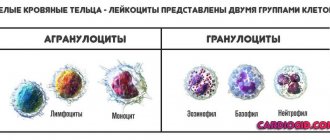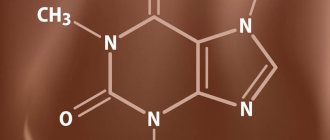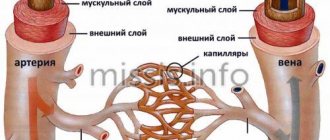The appearance of red-burgundy formations on the skin indicates that capillaries have burst in this area. They are blood vessels with a diameter of 5-10 microns, which have high permeability, participate in metabolism and help enrich the body with oxygen. Often, burst vessels occur after an injury, but their spontaneous formation should alert a person, since this may be a sign of a serious illness.
Main causes of pathology
The capillary network in its structure has arterioles, precapillaries and venules. Capillaries can burst on the body for the following reasons:
- weakness of the capillary wall;
- excessive load on the lower limbs;
- thrombocytopenia;
- hypothermia;
- skin hypersensitivity;
- excess weight;
- cirrhosis of the liver;
- injury;
- diseases of the cardiovascular system;
- vegetative-vascular dystonia;
- exposure to chemicals;
- disturbances in the functioning of the endocrine gland.
Most often, the cause is the individual predisposition of the body, as well as thinning of the capillary wall, due to which it cannot withstand pressure. People suffering from hypertension should regularly examine their body for bleeding on the skin. Bursted capillaries indicate a surge in pressure that went unnoticed. In such patients, the vascular bed has pathological fragility, which can react when the weather changes. Women during pregnancy, childbirth, abortion, hormonal therapy complain that capillaries burst. Basically, when hormonal levels change, such a pathology does not pose a great danger to life and health, but can cause discomfort.
A person with a history of heart attack, stroke or vegetative-vascular dystonia is more prone to fragility of the vascular wall than others.
Return to contents
Recommendations
Are you prone to rosacea or suffer from its manifestations? Then take a few recommendations into account:
- use only special products for sensitive skin and drugs with anti-rosacea effect;
- moisturize your skin regularly;
- wash only with cool or warm water, hot and cold will cause a relapse;
- do not overheat or freeze;
- take vitamin and mineral complexes;
- strengthen capillaries with a contrast shower and facial exercises;
- Eat a diet rich in vitamin C.
Diagnostic methods
To independently check blood vessels for fragility, it is enough to carry out the following tests:
To check the fragility of blood vessels, you can use a tonometer cuff.
- Pinch. Under the clavicle bone, take the skin with two fingers and twist clockwise. If a hematoma or bruise forms, it means that there is thinning of the vessel wall.
- Drag. Inflate the blood pressure cuff by placing it on your forearm and leave for 10 minutes. After time has passed, remove the tourniquet and if red dots appear on the skin, this indicates damage to the capillaries. The patient needs to see a doctor immediately.
- Hammer. The patient's chest is lightly tapped with a hammer; if bruising occurs, the diagnosis of capillary wall weakness is confirmed.
A laboratory diagnostic method is the examination of blood vessels with a special apparatus - a capillaroscope. It is a microscope with a video camera and a monitor, on which the doctor can detect pathology in the integrity of the wall and subsequently prescribe treatment. The patient is recommended to undergo blood and urine tests to determine the general condition of the body.
Return to contents
Prevention of vascular fragility
To prevent vascular rupture, you need to pay attention to doing eye exercises. It is also very effective to drop warm black tea into your eyes from time to time. An excellent way to prevent rupture of blood vessels in the eyes are special vitamin complexes and eye drops. For example, vitamin complexes, including blueberry extract, as well as beta-carotene, have an excellent strengthening effect. Such prevention is especially necessary in winter, when there is a shortage of fresh berries, vegetables and fruits.
You also definitely need vitamins of groups A, B and C, so when choosing a complex of vitamins, be sure to pay attention to whether these elements are included in its composition. Strengthening eye drops, such as Katachrom and Quinax, are also very useful. Due to their composition, they are an effective prevention of many diseases of the organ of vision. The same cannot be said about the well-known Visine, which helps to avoid rupture of blood vessels only if it is applied in a timely manner, for example, after a tiring day at work.
For contact lens users, eye drops that imitate natural tears are ideal. They are especially useful when the eyes need natural hydration.
In the medical department, everyone can undergo examination using the most modern diagnostic equipment, and based on the results, receive advice from a highly qualified specialist. The clinic is open seven days a week and operates daily from 9 a.m. to 9 p.m. Our specialists will help identify the cause of vision loss and provide competent treatment for identified pathologies.
You can make an appointment at the Moscow Eye Clinic by calling 8 8 (499) 322-36-36 (daily from 9:00 to 21:00) or using the online registration form.
Dagaev Adam Huseinovich
Risk factors
Causes of vascular fragility:
- Weakness of the walls of veins and capillaries, disruption of their permeability.
- Vessels in the legs burst due to prolonged stress on them.
- Common causes of ruptured blood vessels are pregnancy, childbirth, the use of oral contraception, abortion, ovarian cysts, fibroids, menopause and other phenomena that cause hormonal imbalance.
- Endocrine disorders in women.
- Poor nutrition.
- Physical inactivity.
- Bad habits.
- Skin damage caused by chemical peels, regular visits to the solarium, frostbite, burns.
- If a vein in the leg bursts, this is a sign of the initial stage of varicose veins.
- Fragile blood vessels can be a consequence of heavy training (the result of changes in blood pressure).
- Infections and viruses weaken the walls of blood vessels. After the underlying disease is treated, the burst capillaries disappear on their own.
- Systemic pathologies can contribute to the fragility of blood vessels in the fingers and toes: diabetes mellitus, obesity, coronary artery disease, angina pectoris, atherosclerosis, hypertension.
- Allergies can also cause the problem. So, when blood vessels on the hands burst, this may be a reaction to household chemicals.
- A lack of vitamins P and C in the body can cause increased fragility of the walls of capillaries and veins. In this case, the following symptoms occur: chills, the skin on the fingers and toes may turn blue. Hematomas due to deficiency of ascorbic acid and rutin form in autumn and winter.
Symptomatic treatment helps eliminate vascular fragility (it is carried out in a hospital and at home). True, when blood vessels burst in the hands due to a systemic disease, for example, hormonal imbalance, they will be damaged again.
The risk group includes people with sedentary jobs (drivers, teachers, office employees). Representatives of these professions are recommended to do a warm-up at least once every two hours - walk around the room, perform rotational movements with their arms, do several bends back, forward and to the sides.
Consequences
The outcome depends on the location of the damage. The most dangerous is a rupture of a blood vessel in the brain. If the patient is not hospitalized in time, the outcome in most cases is fatal. The cause is extensive bleeding in the brain. When localized in the eyeballs, it often goes away on its own even without the use of any therapy. If the cause is external factors, the vessels in the arms and legs are restored within a few days. Often pregnant women complain about the appearance of vascular networks on the mammary gland. This process is provoked by increased production of hormones that promote milk production. Symptoms often go away on their own without the use of medications.
Signs and diagnosis
To establish the degree of vascular damage, the following techniques are used:
- Treatment of cerebral vessels: folk remedies, traditional medicine
- Pinch method: The fold of skin in the chest area should be pinched between the middle and index fingers. Accidental damage is excluded in this area, and pressure on the skin does not cause pain. If after the manipulations a hemorrhagic spot has formed on the tested area, the fragility of the blood vessels is significant.
- Tap the skin in the chest area with a hammer. If hematomas appear after this, the walls of the vessels are weakened.
- Tourniquet method. The middle part of the shoulder is rewound with a tourniquet so that the outflow of venous blood is stopped and arterial blood is not disturbed. If, after removing the tourniquet, petechiae have formed in the area being examined, the degree of vascular fragility is high, and the patient requires medication therapy.
When diagnosing problems with blood vessels, you need to pay attention to the following symptoms:
- Dizziness.
- The appearance of “stars” or black dots before the eyes with a sudden change in body position.
- Even minor injuries result in broken capillaries on the fingers, forearms, ankles, etc.
- A network of blood vessels is visible through the skin.
- Feeling of chills even in a warm room.
Treatment of spider veins on the legs
Spider veins require complex treatment: in most cases it takes place in two stages. The varicose veins feeding the sprocket should be removed first. This is done by sclerotherapy: during the procedure, a special drug, a sclerosant, is injected into the lumen of the vein, which “glues” it together. Thus, it is excluded from the bloodstream, its functions are taken over by other veins. Gradually the sclerotic vessel resolves.
After this, it’s time to remove the asterisk itself, for which doctors at the Phlebology Center use a neodymium laser. Its advantages are the ability to individually select the laser wavelength, as well as the precise, targeted effect of the laser beam on the vessel. The laser has the same effect on the veins as a sclerosant - it glues them together. As a result, small vessels disappear completely, and larger vascular formations, such as hemangiomas, become less noticeable.
For complete or almost complete removal of spider veins, a course of treatment of 2-4 procedures is required.
To make the treatment more effective, as well as to prevent relapses, patients should wear the recommended compression stockings after the procedure, which ensures correct pressure on the veins.
How to understand?
If spider veins are accompanied by a symptom such as dizziness, then you need to visit a doctor.
The first symptom of a broken capillary is the appearance of an asterisk or spider vein on the skin. This design has a bright red or burgundy color. The patient experiences discomfort due to the appearance of hematomas and bruises on the body. Often there is a burning sensation in the area of bursting capillaries. If you feel dizzy, your vision becomes dark when you quickly change body position, even to the point of fainting, and the red mesh grows, you should immediately consult a doctor.
When injured, hemorrhage appears within a few minutes. In the area of impact, the patient feels pain and can visually observe a network of burst capillaries. If the rupture occurs in the eye, a red spot appears on the visible part of the eyeball. In the case of localization of a burst vessel in the brain, symptoms may appear immediately or gradually. The patient feels a rush of blood to the face, a severe headache, breathing slows down, he sees all objects in a red light, and may lose consciousness or fall into a coma.
Return to contents
Why are varicose veins dangerous?
To this question, most of us will probably answer that spider veins are purely an aesthetic problem. Indeed, you no longer want to wear a short skirt or shorts with veined stars. However, this is not the main thing.
A network of small vessels that appears on the skin may indicate that you are developing varicose veins. In particular, you may already have dilated reticular veins - superficial vessels that have a diameter of about 2 mm and feed the spider vein. In addition, a fine network of red or blue vessels may indicate the presence of chronic venous insufficiency - a set of symptoms that indicates poor circulation in the veins.
